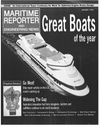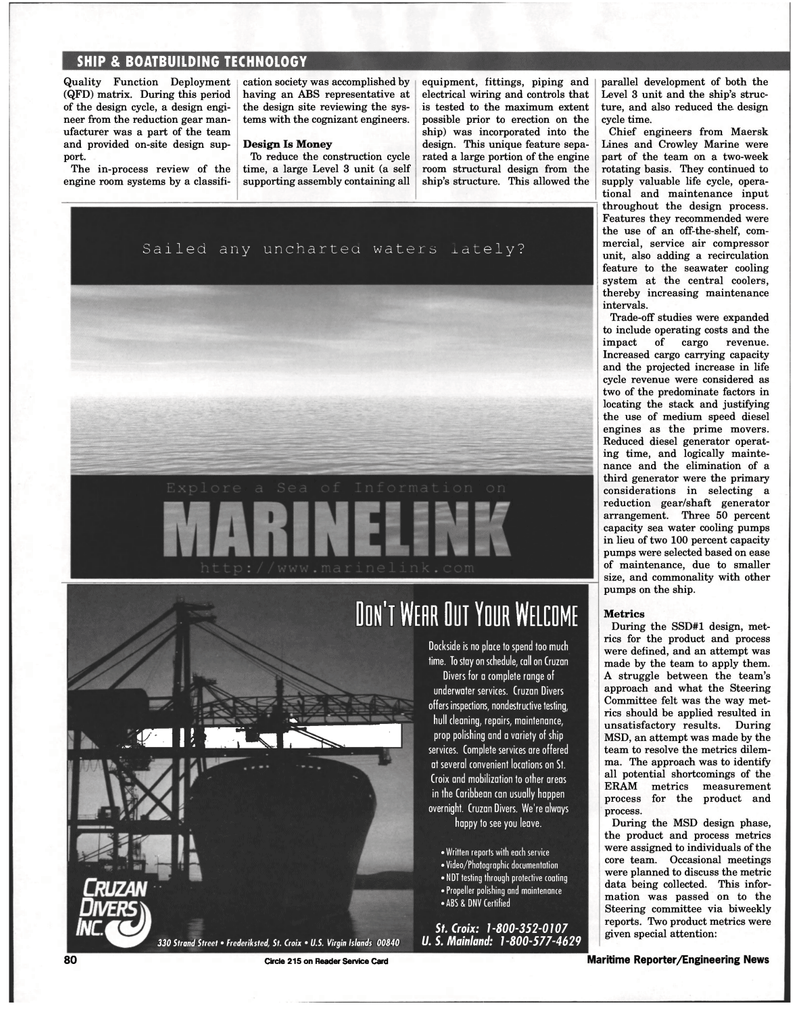
Page 80: of Maritime Reporter Magazine (January 1998)
Read this page in Pdf, Flash or Html5 edition of January 1998 Maritime Reporter Magazine
SHIP & BOATBUILDING TECHNOLOGY
Quality Function Deployment (QFD) matrix. During this period of the design cycle, a design engi- neer from the reduction gear man- ufacturer was a part of the team and provided on-site design sup- port.
The in-process review of the engine room systems by a classifi- cation society was accomplished by having an ABS representative at the design site reviewing the sys- tems with the cognizant engineers.
Design Is Money
To reduce the construction cycle time, a large Level 3 unit (a self supporting assembly containing all equipment, fittings, piping and electrical wiring and controls that is tested to the maximum extent possible prior to erection on the ship) was incorporated into the design. This unique feature sepa- rated a large portion of the engine room structural design from the ship's structure. This allowed the parallel development of both the
Level 3 unit and the ship's struc- ture, and also reduced the design cycle time.
Chief engineers from Maersk
Lines and Crowley Marine were part of the team on a two-week rotating basis. They continued to supply valuable life cycle, opera- tional and maintenance input throughout the design process.
Features they recommended were the use of an off-the-shelf, com- mercial, service air compressor unit, also adding a recirculation feature to the seawater cooling system at the central coolers, thereby increasing maintenance intervals.
Trade-off studies were expanded to include operating costs and the impact of cargo revenue.
Increased cargo carrying capacity and the projected increase in life cycle revenue were considered as two of the predominate factors in locating the stack and justifying the use of medium speed diesel engines as the prime movers.
Reduced diesel generator operat- ing time, and logically mainte- nance and the elimination of a third generator were the primary considerations in selecting a reduction gear/shaft generator arrangement. Three 50 percent capacity sea water cooling pumps in lieu of two 100 percent capacity pumps were selected based on ease of maintenance, due to smaller size, and commonality with other pumps on the ship.
Metrics
During the SSD#1 design, met- rics for the product and process were defined, and an attempt was made by the team to apply them.
A struggle between the team's approach and what the Steering
Committee felt was the way met- rics should be applied resulted in unsatisfactory results. During
MSD, an attempt was made by the team to resolve the metrics dilem- ma. The approach was to identify all potential shortcomings of the
ERAM metrics measurement process for the product and process.
During the MSD design phase, the product and process metrics were assigned to individuals of the core team. Occasional meetings were planned to discuss the metric data being collected. This infor- mation was passed on to the
Steering committee via biweekly reports. Two product metrics were given special attention:
Sailed any uncharted waters lately?
DON'T WEAR OUT YOUR WELCOME
Dockside is no place to spend too much time. To stay on schedule, call on Cruzan
Divers for a complete range of underwater services. Cruzan Divers offers inspections, nondestructive testing, hull cleaning, repairs, maintenance, prop polishing and a variety of ship services. Complete services are offered at several convenient locations on St.
Croix and mobilization to other areas in the Caribbean can usually happen overnight. Cruzan Divers. We're always happy to see you leave. • Written reports with each service • Video/Photographic documentation • NDT testing through protective coating • Propeller polishing and maintenance • ABS&DNV Certified
St. Croix: 1-800-352-0107 330 Strand Street • Frederiksted, St. Croix • U.S. Virgin Islands 00840 U. S. Mainland: 1-800S77-4629 -'<• I lifiSBM 80 Circle 215 on Reader Service Card Maritime Reporter/Engineering News

 79
79

 81
81
